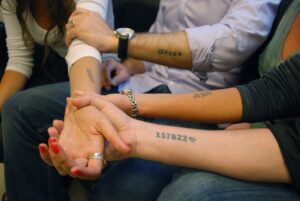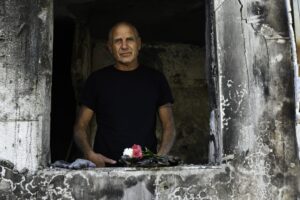Seventy-six years ago, in the Tel Aviv Museum, today known as Independence Hall, the founders of the modern state of Israel held a ceremony. For the first time in 2,000 years, a Jewish political entity existed in the Jewish homeland.
On May 14, hundreds of Jewish community members gathered at the Mayerson JCC to celebrate Yom Haatzmaut, Israeli Independence Day.
Despite the heaviness that has pervaded the Jewish community since Oct. 7, the ensuing Israel-Hamas War, and the 134 Israelis still held hostage, the Mayerson JCC was filled with the parking lot at capacity.
“Being together and showing that we are still here is so important, now more than ever,” Senior Community Shaliach Yarden Neeman said in a statement on the JCC website.
For many community members, the celebration was joyful and a testament to survival and resistance in these challenging times. For Adam Teitelbaum, who attended with his family, it was a vital way to keep the community strong.
“There’s a famous Jewish saying that we don’t have a history; we only have a memory. And so to create the visceral memory experiences of our tradition is a really important part of building a strong Jewish community,” he said.
The day featured several events, including a Hoxworth blood drive and a mitzvah fair with various activities such as making no-sew blankets, crafting kindness rocks, and painting ceramic flowers, all aimed at supporting the community.
Several organizations participated in the fair, including Miami and UC Hillels, Rockwern Academy, the Jewish National Fund, the American Jewish Committee, the Jewish Community Relations Council, Cincinnati Krav Maga, and the Israeli Air Force, that featured a virtual reality flying simulator.
The most popular table was a bake sale by Israeli baker Oz Shahari. All proceeds supported Kibbutz Ma’ayan Baruch, located on the northern border just 400 meters from Lebanon. Members of the kibbutz have been evacuated for months as skirmishes between Israel and Hezbollah have intensified since the start of the Israel-Hamas war.
After the Mitzvah Fair, Israeli photographer and storyteller Eren Kaganovitz discussed his project, Humans of October 7th. This project features stories of survivors, family members, and Israelis affected by the events of that day. Kaganovitz is also behind the popular social media accounts Humans of Tel Aviv and Humans of the Holocaust.
The innovative Humans of New York project partly inspired the Humans of Tel Aviv. Kaganovitz has shared over 2,000 stories of people living in Tel Aviv. He told the crowd his idea was sparked by his travels abroad. He told the crowd how people abroad initially did not realize he is from Israel “probably because of my accent, which I acquired after watching endless episodes of Seinfeld and Friends,” he said.
He recounted his frustration when he told people he was from Israel their expressions would change, and the conversation would immediately turn to conflict, war, terrorism, or politics.
“And remember I told myself that if I had that ability back then to actually take those people back with me to Israel so they can actually see in their own eyes, what Israel and Tel Aviv is all about,” he said. “ I don’t know; maybe just maybe it would be able to change those misconceptions.”
With Humans of Tel Aviv, Kaganovitz didn’t want to paint a rosy picture of Israel but to show the world the complexities of living there, including its LGBT population, religious population, young people, and old people.
“I’m going to show the reality the way it is, and I’m going to let other people connect the dots for themselves,” he said.
Even before Oct. 7, living in Israel could be dangerous, as he acknowledged that living in a country that faces existential threats on multiple borders.
“Living in Israel, it feels sometimes that you are living on the Titanic,” Kaganovitz said. “You know, you’re going to hit the iceberg. But you don’t know when you’re actually going to hit the iceberg.”
He contributes that feeling to the work-hard, play-hard mentality of many Israelis. As he was collecting more stories for the Humans of Israel/Tel Aviv, antisemitism was rising throughout the world. He started the new account, Humans of Holocaust, and discussed one of the stories from the project with the crowd of young Israelis who had their grandparents’ concentration camp numbers tattooed on their arms.

“There’s a lot of discussion in Israel and even in the Jewish world. Are you even allowed to tattoo something on your body?” he said. “But in my eyes, you know, this is a beautiful way to commemorate the memory of the Holocaust.”
Then, Kaganovitz moved the discussion and presentation to his newest project, Humans of October 7th. He recounted his shock and horror that morning, the broken social contract between Israelis, and the government’s response on Oct. 7. Before he shared stories of people he photographed for the project.
“Growing up in Israel, you grow up with this sense that no matter what is actually happening in the country, the government and the IDF will always be there for you…And on Oct 7, they couldn’t even send soldiers in the first hours to save the civilians and the families and the babies in the Gaza enclave,” he said. “So something really basic about that feeling of being Israeli actually was shattered into pieces on that morning.”
A month after Oct. 7, Kaganovitz went to Kibbutz Be’eri, where one of the worst massacres of Israeli civilians took place. It is less than three miles from the Gaza border.
“I remembered that the first thing that actually caught me was the smell. It still smelled like a fire a month later.”
Kaganovitz shared the story of Kibbutz Be’eri resident Haim Jellin, who held the door of his shelter shut while they hid for eight hours before the IDF rescued them. After photographing Haim, he asked how he felt a month after Oct. 7, and Jellin’s only reply was, “I’m alive.”
“He told me that you can destroy infrastructures and you can destroy houses, but cannot kill our spirits. And he’s planning is to come back to Be’eri.”
Kaganovitz asked the gathered crowd how they felt looking at the photo; some said it reminded them of the destruction or was similar to placing flowers on a grave. But Kaganovitz who delighted in the different interpretations, said it was about something different than the devastation.
“My aim in putting this picture together was that I wanted it to be about hope and resilience,” he said.
Haim Jellin hasn’t lost his hope, Kaganovitz recounted.
“I asked him about his plans for the future, And he told me that you can destroy infrastructures and you can destroy houses, but you cannot kill our spirits.”
Kaganovitz also shared the story of Hamid Abu Ar’rar, who was born in Rafah and had resettled in Israel after marrying an Arab Israeli. Hamid was on his way to work with his wife and baby on October 7th when their car was sprayed with bullets from Hamas terrorists. His wife was killed instantly, and Hamid grabbed his baby and hid in an electric shed for hours.
Hamid then saved Israeli soldiers who were about to be ambushed by Hamas terrorists when he ran out of the shed and warned them.
And the story of Rami Davidian, who lived on a Moshav near the Nova music festival and spent the early morning saving and picking up festival survivors in his truck.
For Kaganovitz, documenting and sharing the stories of Oct. 7 is a way to help repair Israel’s broken social contract because, for him, Israel is at a turning point.
“In the first weeks, the first month after October 7, the whole Israeli society actually pulled together,” Kaganovitz said. “There was this sense of unity, a shared goal.”
Since the fault lines in Israeli society have shown, there have been mass protests against the Netanyahu government, which many Israelis feel is not doing enough for a hostage deal.
“There has to be some kind of a new social contract in Israel. So people from all aspects of life can actually live together.”
He pointed out that Jewish sovereignty and statehood have rarely lasted more than 80 years throughout history.
“We’re celebrating 76 years of Jewish sovereignty and independence. If we want to reach our centennial year, we have to pull things together.”

















